目录
🌈前言
本篇文章进行数据结构中哈希表的学习!!!
🌅哈希表
🚁1、哈希概念
概念:
-
在以往的顺序结构以及平衡树中,元素关键码(key)与其存储位置之间没有对应的关系,因此在查找一个元素时,必须要经过关键码的多次比较
-
顺序查找时间复杂度为O(N),平衡树中为树的高度,即O(long2N),搜索的效率取决于搜索过程中元素的比较次数
理想的搜索方法:
-
可以不经过任何比较,一次直接从表中得到要搜索的元素。
-
如果构造一种存储结构,可以通过某种哈希函数(hashFunc)使元素的存储位置与它的关键码之间能过建立一一映射的关系,那么在查找时通过该函数可以很快找到该元素
当向该结构进行:
-
插入元素:根据待插入元素的关键码,再使用一个函数计算出该元素的存储位置并按此位置进行存放
-
搜索元素:对元素的关键码进行同样的计算,把求得的函数值当做元素的存储位置,在结构中按此位置取元素比较,若关键码相等,则搜索成功
-
该方式即为哈希(散列)方法,哈希方法中使用的转换函数称为哈希(散列)函数,构造出来的结构称为哈希表(Hash Table)(或者称散列表)
- 例如:我们有一组数据 {1,3,6,8,9}
- 哈希函数设置为:hash(key) = key % capacity,capacity为存储元素底层空间总的大小
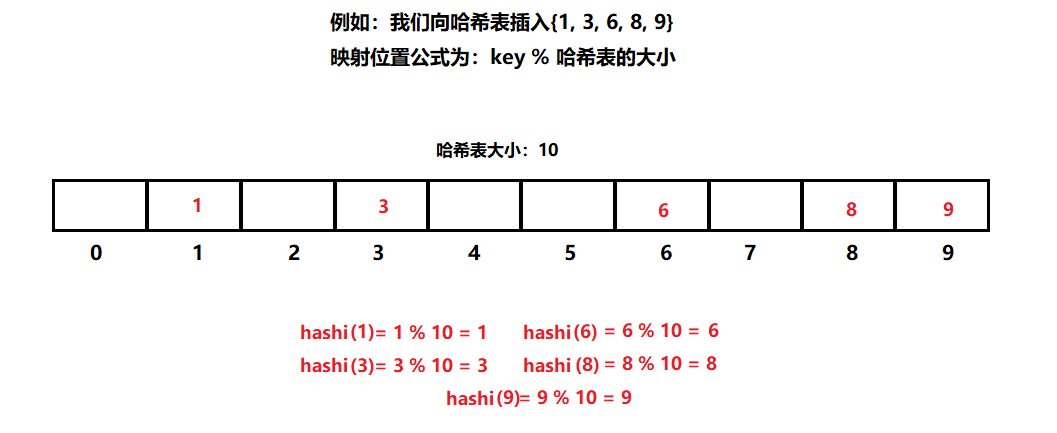
总结:使用该方法,不用对关键码进行多次比较,所以搜索速度很快!!!
🚂2、哈希冲突
哈希冲突:
-
对于两个数据元素的关键字Ki和Kj(i != j),有Ki != Kj,但也有:Hash(Ki) == Hash(Kj),即:
-
不同关键字通过相同的哈希函数计算出相同的映射地址,该现象成为哈希冲突或哈希碰撞
-
把具有不同关键码而具有相同哈希地址的数据元素称为“同义词”
🚃3、哈希函数
引起哈希冲突的原因可能是:哈希函数设计不够合理。哈希函数设计原则:
-
哈希函数计算出来的地址能均匀分布在整个空间中
-
哈希函数应该比较简单
-
哈希函数的定义域必须包括需要存储的全部关键码,而如果散列表允许有m个地址时,其值域必须在0到m-1之间(哈希表从下标为0开始)
常见哈希函数:
- 直接定址法(常用):
-
取关键字的某个线性函数为散列地址:Hash(Key) = A * Key + B,优点:简单,均匀,但是需要事先知道关键字的分布状况
-
使用场景:适合查找比较小且连续的情况:【字符串中第一次出现一次的字符】
- 除留余数法(常用)
- 设散列表中允许的地址数为m,取一个不大于m,但最接近或者等于m的质数p作为除数,按照哈希函数:Hash(Key) = Key % p(p <= m),将关键码转换成哈希地址
- 平方取中法(了解)
-
假设关键字为1234,它平方就是1522756,抽取中间值3位227作为哈希地址;再比如关键字为4321,它平方就是18671041,抽取中间值3位671(或710)作为哈希地址
-
应用场景:不知道关键字的分布,而位数又不是很大的情况
- 折叠法(了解)
- 折叠法是将关键字从左到右分割成位数相等的几部分(最后一部分的位数可以短些),然后将这几部分叠加求和,并按散列表表长,取后几位作为散列地址
- 随机数法(了解)
- 选择一个随机函数,取关键字的随机函数值作为它的哈希地址,即:Hash(Key)= random(Key),其中random为随机数函数
🚄4、哈希冲突解决方法
🌈前言:解决哈希冲突的两种常用方法:闭散列和开散列
🚅4.1、闭散列
- 闭散列:也叫开放定址法,当发生哈希冲突时,如果哈希表没有被装满,说明在哈希表中必然还有空位置,那么可以把key存放到冲突位置的”下一个“空位置中去“
🚆4.1.1、线性探测
- 线性探测:从发生冲突的位置开始,依次向后探测,直到找到下一个空位置为止
插入:
-
插入关键字(key)时,通过哈希函数获取待插入元素在哈希表中的位置
-
如果该位置中没有元素则直接插入新元素,如果该位置中有元素发生哈希冲突,使用线性探测找到下一个空位置,插入新元素
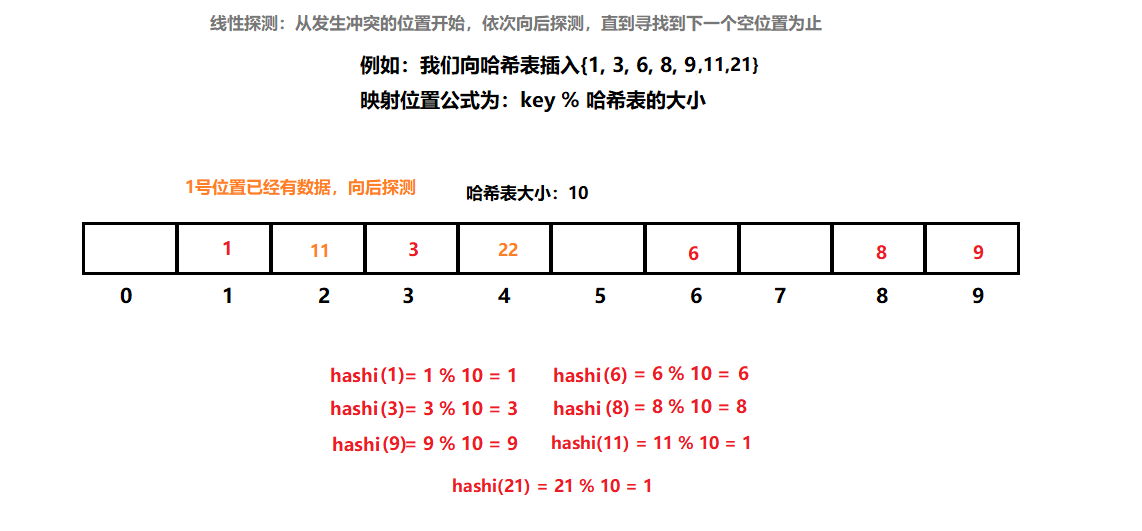
删除:
-
采用闭散列处理哈希冲突时,不能随便物理删除哈希表中已有的元素,若直接删除元素会影响其他元素的搜索,比如:删除元素11,直接删除会给后面查找22带来很大的影响
-
线性探测可以设计一个枚举来标记哈希表中每个位置的状态是”空“,”存在“还是”删除“,然后使用伪标记法进行删除,将状态改为”DELETE“
// 哈希表每个空间给个标记
enum State
{
EMPTY, // 空状态
EXIST, // 存在状态
DELETE // 已删除状态
}
闭散列的扩容:

关于关键值(key)自定义类型问题:
- 如果关键值是自定义类型时,我们就不能将他隐式的转换成为无符号整数,需要实现一个仿函数来进行转换,一般只需要转换string,后面增加直接特化即可
// key为sring
template <typename K>
struct HashDF
{
size_t operator()(const string& str)
{
size_t hash_sum = 0;
for (auto& e : str)
{
hash_sum = hash_sum * 131 + e;
}
return hash_sum;
}
};
// 模板特化...
template <>
struct HashDF<...>
{};
线性探测的实现:
namespace CloseHash
{
// key为sring
template <typename K>
struct HashDF
{
size_t operator()(const string& str)
{
size_t hash_sum = 0;
for (auto& e : str)
{
hash_sum = hash_sum * 131 + e;
}
return hash_sum;
}
};
// 哈希表中值的状态
enum State
{
EMPTY, // 空
EXIST, // 存在
DELETE // 删除
};
template<typename K, typename V>
struct HashData
{
pair<K, V> _kv;
State _state = EMPTY; // 插入扩容时默认初始化为空状态
};
template<typename K, typename V, typename Function = HashDF<K>>
class HashTable
{
private:
typedef HashData<K, V> HD;
public:
bool Insert(const pair<K, V>& kv)
{
// unordered_map不允许冗余
if (Find(kv.first) != nullptr)
return false;
// 负载因子到0.75及以上,就扩容
if (_tables.size() == 0 || _n * 100 / _tables.size() >= 75)
{
size_t newSize = _tables.size() == 0 ? 10 : _tables.size() * 2;
// 扩容以后,需要重新映射 -- 如果直接拷贝,则导致映射位置的改变
HashTable<K, V> newHT;
newHT._tables.resize(newSize);
// 遍历旧表,插入newHT
for (auto& e : _tables)
{
if (e._state == EXIST)
{
newHT.Insert(e._kv);
}
}
// 使用vector中swap成员函数进行交换
newHT._tables.swap(_tables);
}
// 将插入的值转换成无符号整形然后%哈希表(有效数据)大小 -- 处理负数情况
size_t starti = df(kv.first);
starti %= _tables.size();
size_t hashi = starti;
size_t i = 1;
while (_tables[hashi]._state == EXIST)
{
// hashi = starti + (i * i); // 二次探测
hashi = starti + i; // 线性探测
++i;
hashi %= _tables.size();
}
_tables[hashi]._kv = kv;
_tables[hashi]._state = EXIST;
_n++;
return true;
}
bool erase(const K& key)
{
// 查找是否存在
HD* p = Find(key);
// 不为空则修改值的状态未DELETE(删除)
if (p != nullptr)
{
p->_state = DELETE;
--_n;
return true;
}
return false;
}
HD* Find(const K& key)
{
if (_tables.size() == 0)
return nullptr;
size_t starti = df(key);
starti %= _tables.size();
size_t hashi = starti;
size_t i = 1;
// 值的状态不为空就继续查找
while (_tables[hashi]._state != EMPTY)
{
// 值的状态不为删除状态并且key相等
if (_tables[hashi]._state != DELETE && _tables[hashi]._kv.first == key)
{
return &_tables[hashi];
}
hashi = starti + i;
++i;
hashi %= _tables.size(); // 防止非法访问
}
return nullptr;
}
private:
vector<HD> _tables;
size_t _n = 0; // 存储关键字个数
Function df;
};
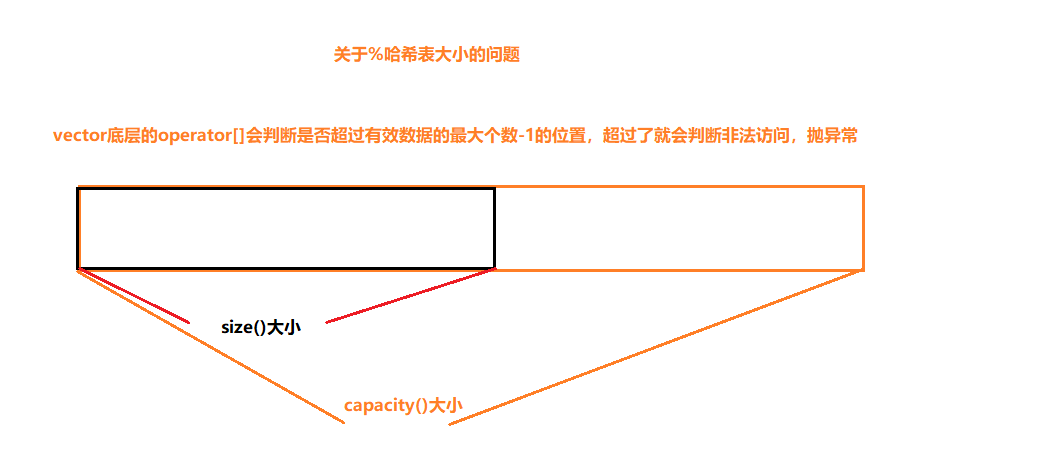
总结:
-
线性探测的优点:原理简单,实现起来也不麻烦
-
缺点:一旦发生哈希冲突,所有的冲突连在一起,容易产生数据“堆积”,即:不同关键码占据了可利用的空位置,使得寻找某关键码的位置需要许多次比较,导致搜索效率降低
🚇4.1.2、二次探测
- 二次探测:线性探测的缺陷是产生冲突的数据堆积在一块,这与其找下一个空位置有关系,因为找空位置的方式就是挨着往后逐个去找,因此二次探测为了避免该问题
插入:
- 找下一个空位置的方法为:H = (H0 + i2) % m,或者:H = (H0 - i2) % m,。其中:i = 1,2,3…, 是通过散列函数Hash(x)对元素的关键码 key 进行计算得到的位置,m是表的大小
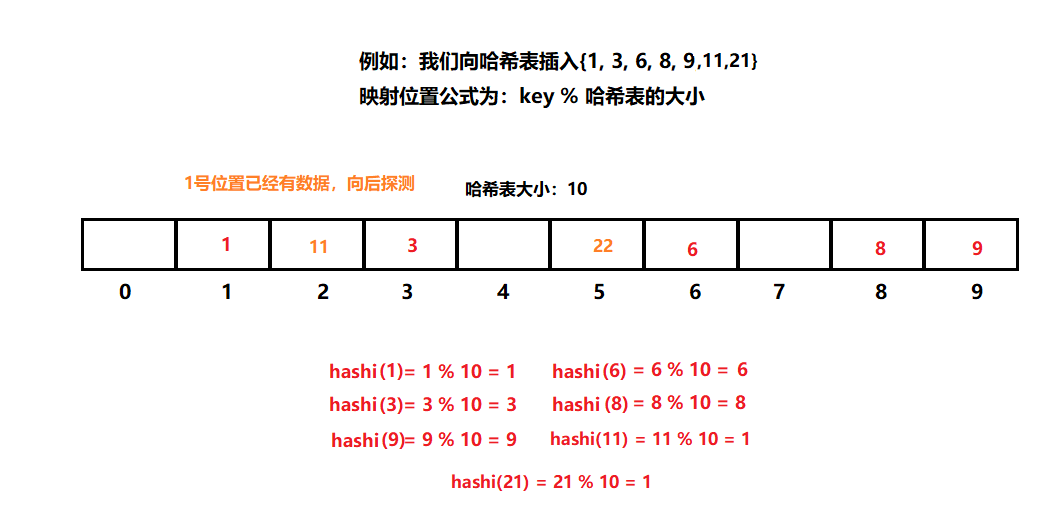
注意:二次探测就不实现了,跟线性探测基本一致,就是hashi每次走i2步
-
研究表明:当表的长度为质数且表装载因子a不超过0.5时,新的表项一定能够插入,而且任何一个位置都不会被探查两次。因此只要表中有一半的空位置,就不会存在表满的问题。在搜索时可以不考虑表装满的情况,但在插入时必须确保表的装载因子a不超过0.5,如果超出必须考虑增容
-
闭散列最大的缺陷就是空间利用率比较低,这也是哈希的缺陷
🚈4.2、开散列
🚉4.2,1、概念及结构
开散列的概念:
-
开散列也叫链地址法(哈希桶),首先对关键码集合用散列(哈希)函数计算散列地址,具有相同地址的关键码归于同一子集合
-
每一个集合称为一个桶,各个桶的元素通过一个链表链接起来,各链表的头节点存储在哈希表中…
// 哈希表节点 -- 这里实现的是键对值结构
template <typename K, typename V>
struct HashNode
{
public:
HashNode(const pair<K, V>& kv)
: _kv(kv)
, _next(nullptr)
{}
public:
pair<K, V> _kv;
HashNode<K, V>* _next;
};
template <typename K, typename V, typename hashF = HashDF<K>>
class HashTable
{
private:
vector<Node*> _tables;
size_t _n = 0;
hashF HashDF;
};
🚐4.2,2、插入
- 开散列的插入:
- 哈希桶的结构:哈希桶其实是一个数组指针,每个桶(数组中的元素)里面存储的是一个链表
- 链表里面有指向下一个节点的指针和值域
- 插入数据就相当于对链表进行头插就行了,将关键码映射的地址直接头插到对应的桶中
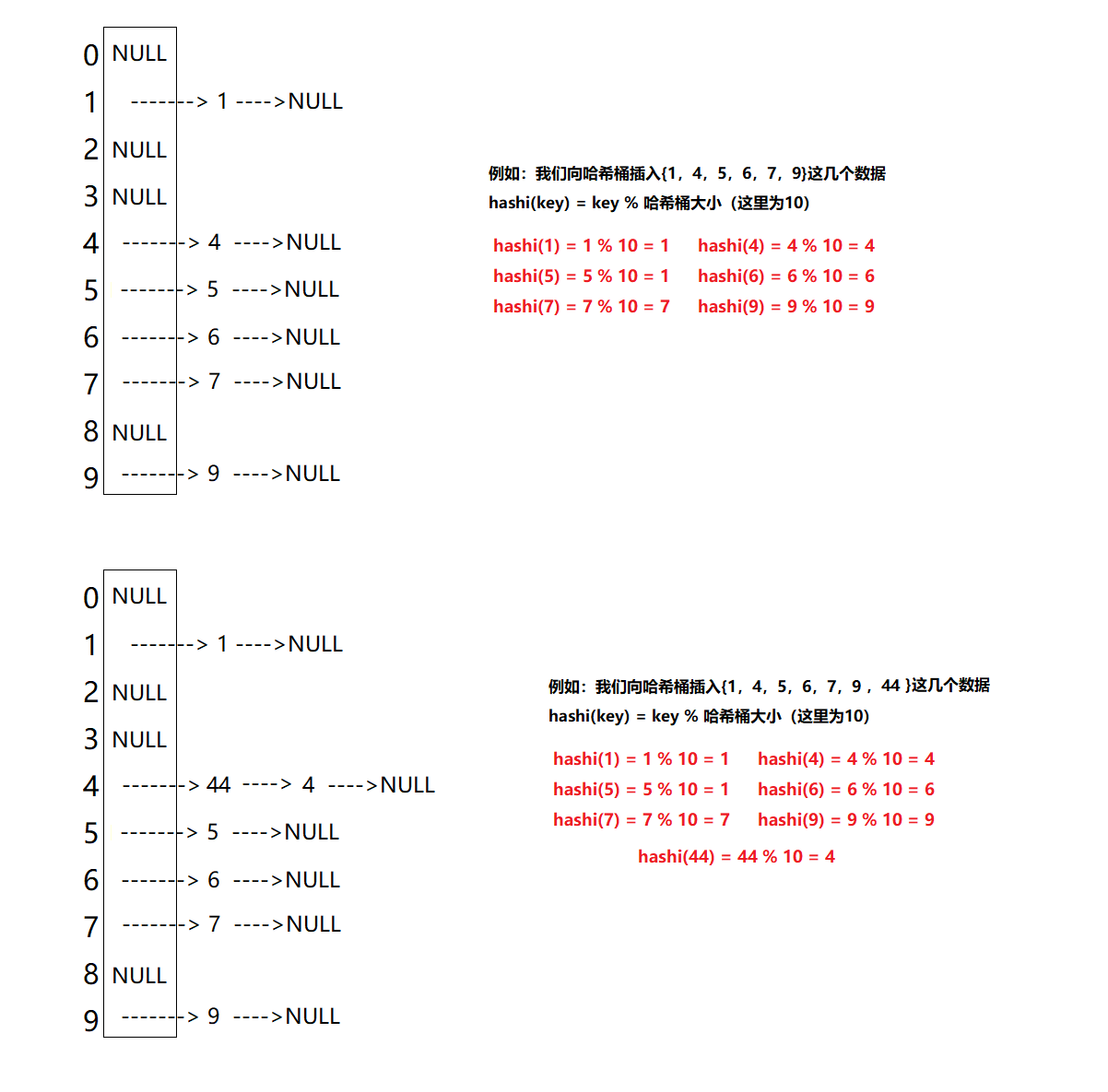
注意:从上图可以看出,开散列中每个桶中放的都是发生哈希冲突的元素,冲突的值在链表中进行头插
bool Insert(const pair<K, V>& kv)
{
// 判断key是否存在哈希桶中,不冗余版本
if (Find(kv.first))
return false;
// 跟闭散列的方法一样需要继续模表大小,找桶位置
size_t hashi = kv.first;
hashi %= _tables.size();
// 构造需要插入的键对值,然后插入到映射的位置 -- 画图
Node* newNode = new Node(kv);
newNode->_next = _tables[hashi];
_tables[hashi] = newNode;
++_n;
return true;
}
插入操作:
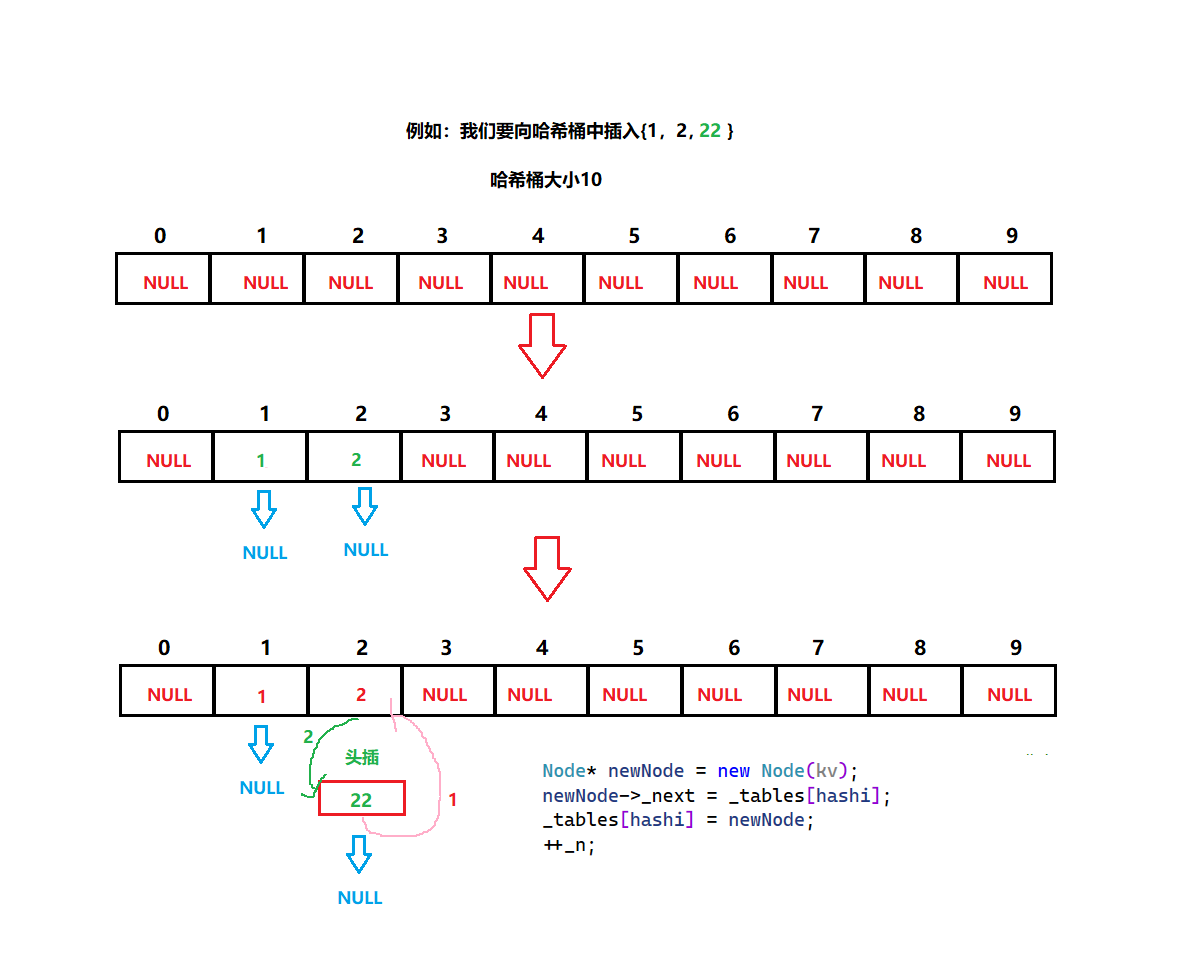
🚑4.2,3、扩容
- 开散列的扩容
-
桶的个数是一定的,随着元素的不断插入,每个桶中元素的个数不断增多,极端情况下,可能会导致一个桶中链表节点非常多,会影响的哈希表的性能,因此在一定条件下需要对哈希表进行增容
-
开散列最好的情况是:每个哈希桶中刚好挂一个节点,再继续插入元素时,每一次都会发生哈希冲突,因此,在元素个数刚好等于桶的个数时,可以给哈希表增容
void _CheckCapacity()
{
if (_tables.size() == 0 || _tables.size() == _n)
{
size_t NewSize = _tables.size() == 0 ? 10 : _tables.size() * 2;
// 把旧哈希桶的节点重新映射到新开辟的哈希桶
HashTable newHT;
newHT._tables.resize(NewSize, nullptr);
for (size_t i = 0; i < _tables.size(); ++i)
{
Node* cur = _tables[i];
while (cur != nullptr)
{
// 将旧哈希桶的值挪到新哈希桶中 -- 头插
Node* next = cur->_next; // 保存下一个节点,挪动后防止找不到
// 需要重新映射新扩容后的哈希桶,模新长度的哈希桶
size_t hashi = HashDF(cur->_kv.first) % NewSize;
cur->_next = newHT._tables[hashi];
newHT._tables[hashi] = cur;
cur = next;
}
_tables[i] = nullptr;
}
newHT._tables.swap(_tables);
}
}
🚒4.2,4、删除
- 开散列的删除:
-
删除其实很简单,比find和insert难度还低
-
首先找到这个关键码映射在哪个桶中然后在这个桶中进行查找,找到进行删除,相当于链表的删除
bool erase(const K& key)
{
// 找这个关键字(key)在哪个桶中
size_t hashi = key;
hashi %= _tables.size();
// 维护一个前驱指针,找到删除节点后直接链接到删除节点下一个节点
Node* cur = _tables[hashi];
Node* prev = nullptr;
while (cur != nullptr)
{
if (cur->_kv.first == key)
{
// 删除位置为"头"
if (prev == nullptr)
{
_tables[hashi] = cur->_next;
}
else
{
prev->_next = cur->_next;
}
delete cur;
--_n;
return true;
}
prev = cur;
cur = cur->_next;
}
return false;
}
}
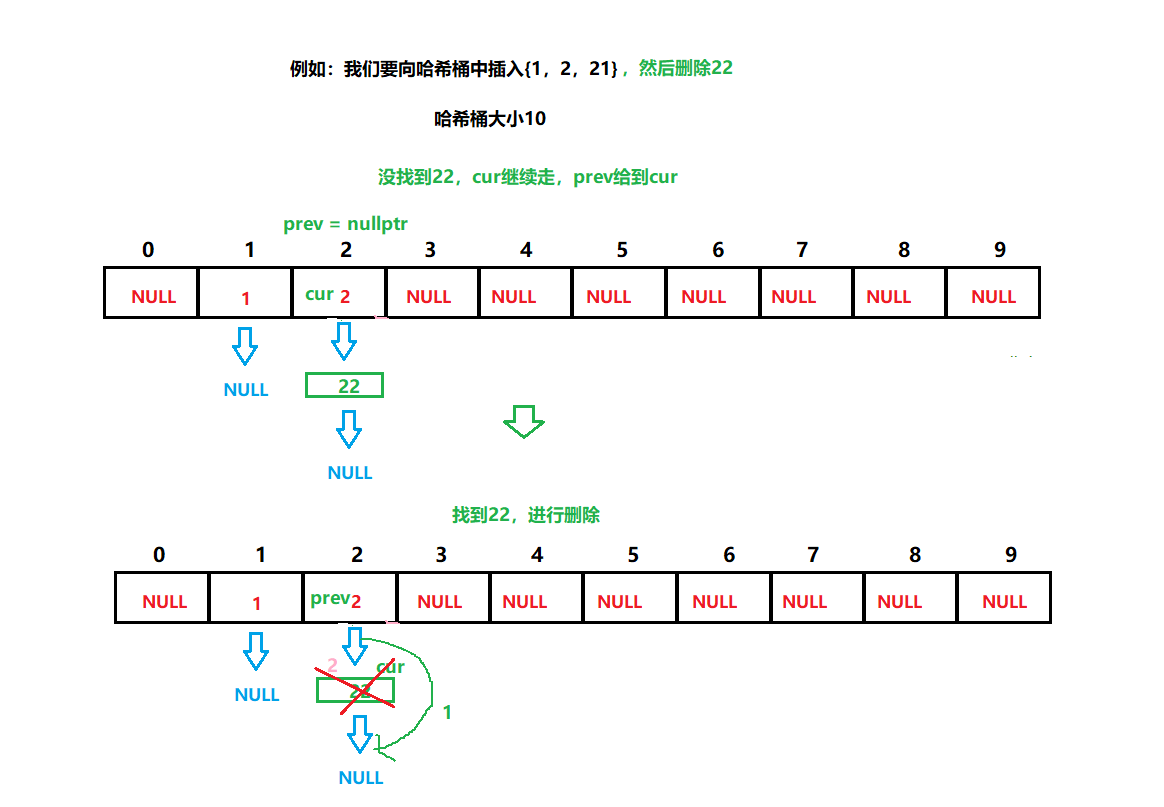
🚓4.2,5、思考
- 开散列的思考:
只能存储key为整形的元素,那么自定义类型要怎么解决呢???
-
这时候就体现到仿函数的价值了,可以套一层仿函数来进行转换
-
可以将这个自定义类型底层可以转换的东西都转换成无符号整形
// 仿函数:处理特殊的Key值问题 -- 后面需要对数据进行无符号整形转换
template <typename K>
struct HashDF
{
size_t operator()(const K& key)
{
return static_cast<size_t>(key);
}
};
template <>
struct HashDF<string>
{
size_t operator()(const string& str)
{
size_t HDS = 0;
for (auto& e : str)
{
HDS = HDS * 131 + static_cast<size_t>(e);
}
return HDS;
}
};
template <typename K, typename V, typename hashF = HashDF<K>>
class HashTable
{
private:
vector<Node*> _tables;
size_t _n = 0;
hashF HashDF;
}
🚔5、哈希桶完整代码
#pragma once
#include <iostream>
#include <vector>
using namespace std;
// 哈希桶(指针数组):哈希表中存储指针,这个指针存储映射的值,映射相同位置时,创建新的节点直接链到这个指针中
namespace BUCKetHash
{
// 仿函数:处理特殊的Key值问题 -- 后面需要对数据进行无符号整形转换
template <typename K>
struct HashDF
{
size_t operator()(const K& key)
{
return static_cast<size_t>(key);
}
};
template <>
struct HashDF<string>
{
size_t operator()(const string& str)
{
size_t HDS = 0;
for (auto& e : str)
{
HDS = HDS * 131 + static_cast<size_t>(e);
}
return HDS;
}
};
// 哈希表节点
template <typename K, typename V>
struct HashNode
{
public:
HashNode(const pair<K, V>& kv)
: _kv(kv)
, _next(nullptr)
{}
public:
pair<K, V> _kv;
HashNode<K, V>* _next;
};
template <typename K, typename V, typename hashF = HashDF<K>>
class HashTable
{
private:
typedef HashNode<K, V> Node;
public:
HashTable() = default;
HashTable(const HashTable& ht)
{
_tables.resize(ht._tables.size(), nullptr);
for (size_t i = 0; i < ht._tables.size(); ++i)
{
Node* cur = ht._tables[i];
while (cur != nullptr)
{
this->Insert(cur->_kv);
cur = cur->_next;
}
}
}
HashTable& operator=(const HashTable ht)
{
HashTable tmp(ht);
this->_n = tmp._n;
tmp._tables.swap(_tables);
return *this;
}
~HashTable()
{
for (size_t i = 0; i < _tables.size(); ++i)
{
Node* cur = _tables[i];
while (cur != nullptr)
{
Node* next = cur->_next;
delete cur;
cur = next;
}
_tables[i] = nullptr;
}
}
bool Insert(const pair<K, V>& kv)
{
if (Find(kv.first))
return false;
if (_tables.size() == 0 || _tables.size() == _n)
{
size_t NewSize = _tables.size() == 0 ? 10 : _tables.size() * 2;
// 这种方法是拷贝,效率低
/*HashTable newHT;
newHT._tables.resize(NewSize, nullptr);
for (size_t i = 0; i < _tables.size(); ++i)
{
Node* cur = _tables[i];
while (cur != nullptr)
{
newHT.Insert(_tables[i]->_kv);
}
}
newHT._tables.swap(_tables);*/
// 把旧哈希桶的节点重新映射到新开辟的哈希桶
HashTable newHT;
newHT._tables.resize(NewSize, nullptr);
for (size_t i = 0; i < _tables.size(); ++i)
{
Node* cur = _tables[i];
while (cur != nullptr)
{
// 将旧哈希桶的值挪到新哈希桶中 -- 头插
Node* next = cur->_next; // 保存下一个节点,挪动后防止找不到
size_t hashi = HashDF(cur->_kv.first) % NewSize; // 需要重新映射新扩容后的哈希桶,模新长度的哈希桶
cur->_next = newHT._tables[hashi];
newHT._tables[hashi] = cur;
cur = next;
}
_tables[i] = nullptr;
}
newHT._tables.swap(_tables);
}
// 跟闭散列的方法一样需要继续模表大小
size_t hashi = HashDF(kv.first);
hashi %= _tables.size();
// 构造需要插入的键对值,然后插入到映射的位置 -- 画图
Node* newNode = new Node(kv);
newNode->_next = _tables[hashi];
_tables[hashi] = newNode;
++_n;
return true;
}
bool erase(const K& key)
{
size_t hashi = HashDF(key);
hashi %= _tables.size();
Node* cur = _tables[hashi];
Node* prev = nullptr;
while (cur != nullptr)
{
if (cur->_kv.first == key)
{
// 删除位置为"头"
if (prev == nullptr)
{
_tables[hashi] = cur->_next;
}
else
{
prev->_next = cur->_next;
}
delete cur;
--_n;
return true;
}
prev = cur;
cur = cur->_next;
}
return false;
}
Node* Find(const K& key)
{
if (_tables.size() == 0)
return nullptr;
// 查找跟闭散列差不多
size_t hashi = HashDF(key);
hashi %= _tables.size();
// 对映射的位置进行循环遍历查找
Node* cur = _tables[hashi];
while (cur != nullptr)
{
if (cur->_kv.first == key)
return cur;
cur = cur->_next;
}
return nullptr;
}
private:
vector<Node*> _tables;
size_t _n = 0;
hashF HashDF;
};
}
总结:开散列与闭散列比较
-
应用链地址法(哈希桶)处理溢出,需要增设链接指针,似乎增加了存储开销
-
事实上: 由于开地址法必须保持大量的空闲空间以确保搜索效率,如二次探查法要求装载因子a <= 0.7,而表项所占空间又比指针大的多,所以使用链地址法反而比开地址法节省存储空间